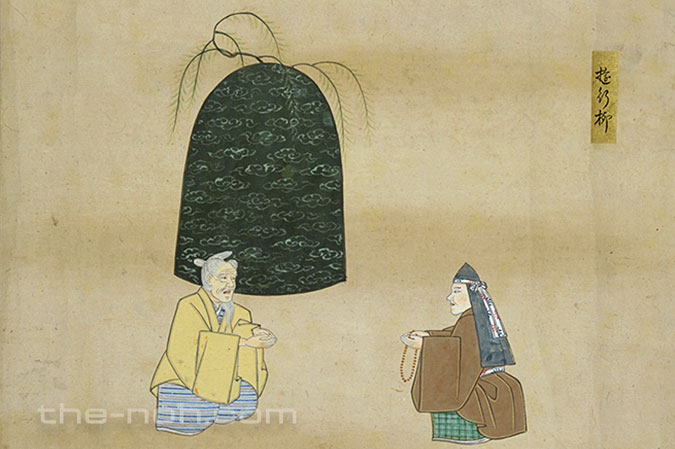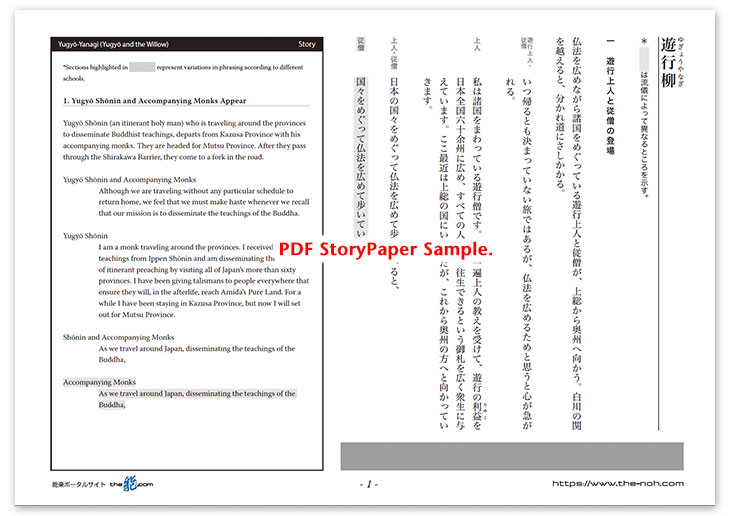
 Yugyō-Yanagi
Yugyō-Yanagi

![]()
Yugyō Shōnin (literally, “Itinerant Holy Man,” the honorary title of leaders of Ippen’s disciples), is traveling around the provinces to disseminate the teachings of Ippen Shōnin (Ippen). He passes through the Shirakawa Barrier on his way to Mutsu Province. When the road comes to a fork, he decides to travel along the wider road. Just then, an old man calls out to Yugyō Shōnin and guides him to the old path, upon which a former yugyō shōnin traveled. As they walk along the rough old path that has fallen into disrepair, the old man tells him that the willow tree growing on an old mound is a famous tree called the Withered Willow, which is even the subject of a poem composed by Monk Saigyō. When Yugyō Shōnin recites ten incantations of the name of Amida Buddha for the old man’s sake, the old man leans against the Withered Willow and then vanishes into thin air.
A villager appears and recounts the ancient story of the Withered Willow and Monk Saigyō. He surmises that the old man who Yugyō Shōnin just met was the spirit of the Withered Willow and suggests that Yugyō Shōnin hold a memorial service if he would like to see something wondrous. Yugyō Shōnin recites a prayer to Amida Buddha and while he is taking a nap, the spirit of the Withered Willow appears, having transformed itself into an old man with gray hair. He reveals that he himself is actually the old man who guided Yugyō Shōnin earlier that day. He gives thanks to Amida Buddha and the power of invoking Amida’s name and tells stories featuring willows, found in legends and Genji Monogatari (The Tale of Genji). When the spirit performs a dance to express his gratitude to Yugyō Shōnin, a wind blowing from the west scatters the willow leaves. After the wind blows, the Withered Willow is left standing alone.
![]()
This is one of the final plays written by Kanze Nobumitsu. Unlike many of his other, flashy pieces, such as Momijigari (Viewing the Autumn Foliage) and Funa-Benkei (Benkei in a Boat), this unusual play has a tranquil atmosphere. Although the storyline develops around an old willow tree, it still has moments of splendor. This play makes reference to Saigyō-zakura (Saigyō and the Cherry Tree) written by Zeami. Although most third-group Noh plays have female lead characters, this piece is unique in that its lead character is the spirit of the willow, which transforms itself into an old man with gray hair.
In the second half of the drama, the spirit of the willow tree makes its appearance from within a stage prop. Although he is the same old man from the first half of the drama, he wears a dignified jō mask and formal attire that lend him a clean, polished atmosphere. One of the highlights of this drama is the kuse section, which mentions many stories featuring willows. Of particular interest are the descriptive performances of a kemari ball game and a cat on a leash drawing up a blind. The old man performs jo-no-mai, an elegant dance usually performed by a female character. The drum beat creates momentum in the tranquil, elegant atmosphere.
STORY PAPER : Yugyō-Yanagi
Story Paper presents noh chant stories in modern speech, with story outlines, highlights and more using Adobe PDF format, which can print out and zoom in. Print out the pages and take them with you when you see the actual noh performance.

The copyright of Story Paper is held by the Noh.com. Story Paper is for individual use only. It is prohibited by the copyright law to distribute or publish printed-out Story Paper pages without prior consent. For more information, check the credit and disclaimer pages.



 [Yugyō-Yanagi : Story Paper PDF : 532KB
[Yugyō-Yanagi : Story Paper PDF : 532KB